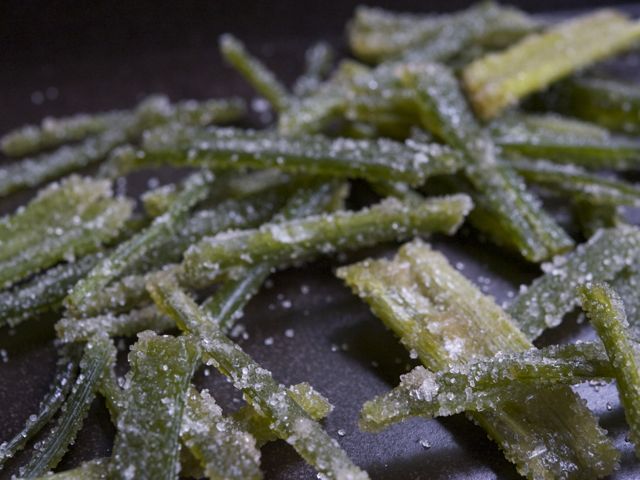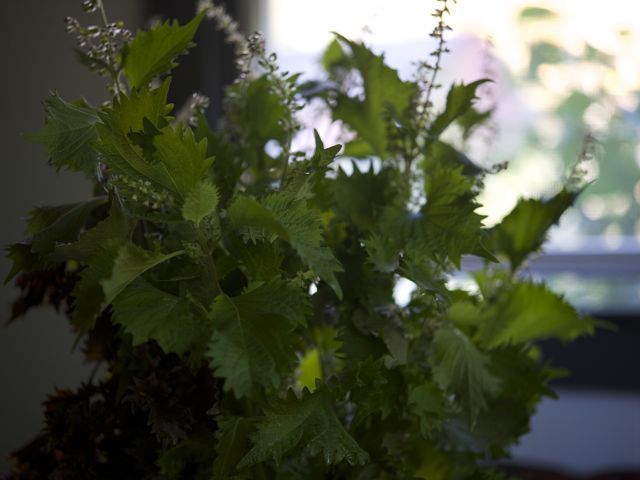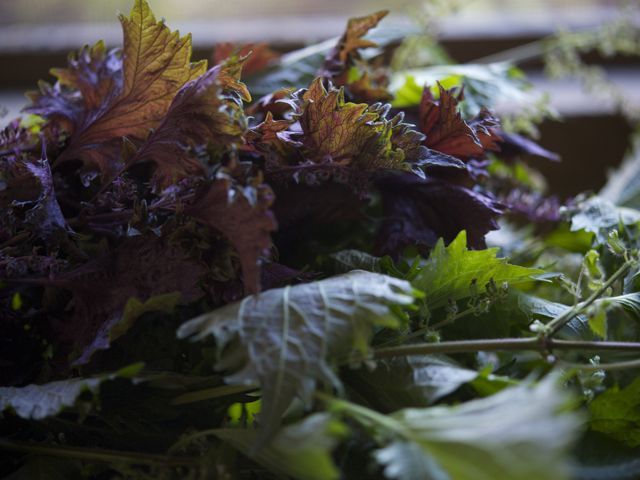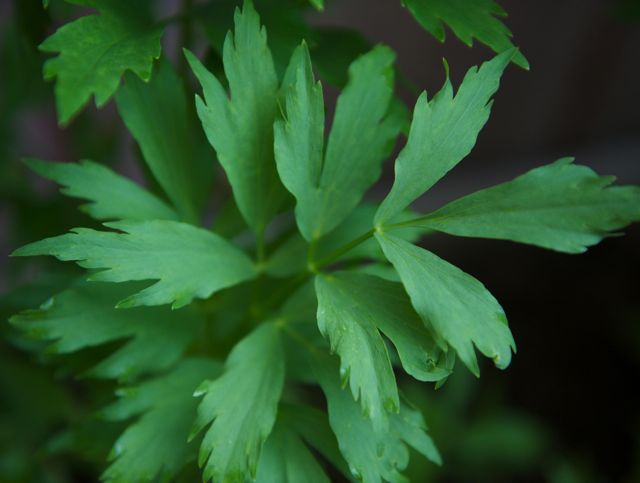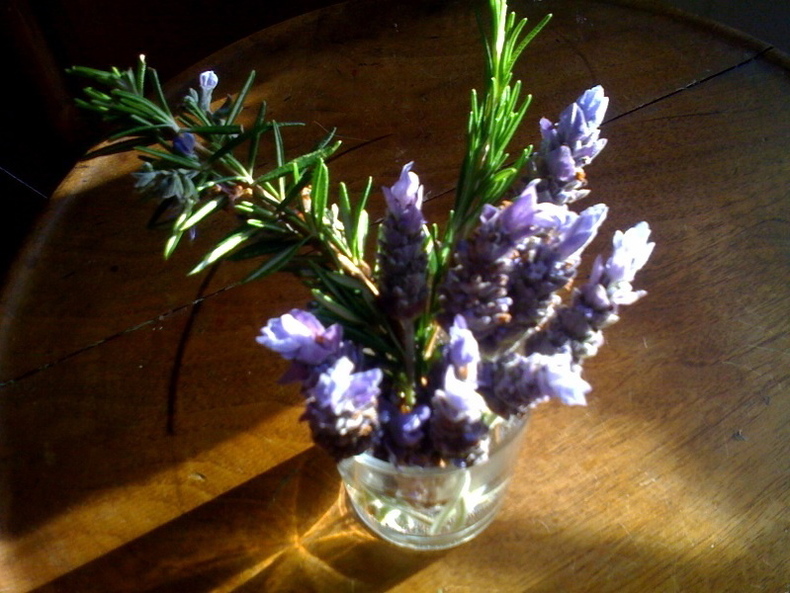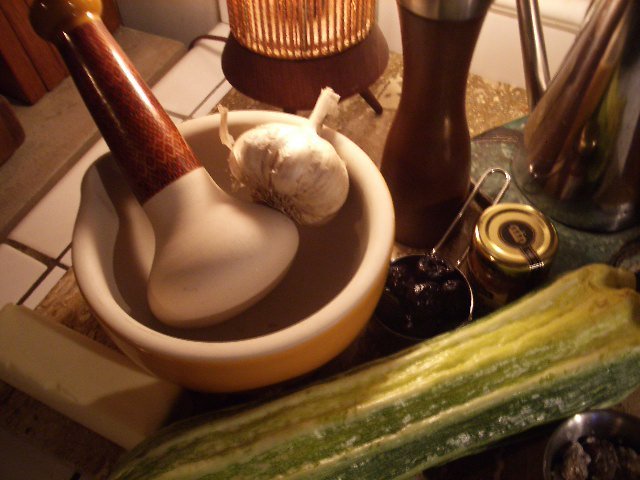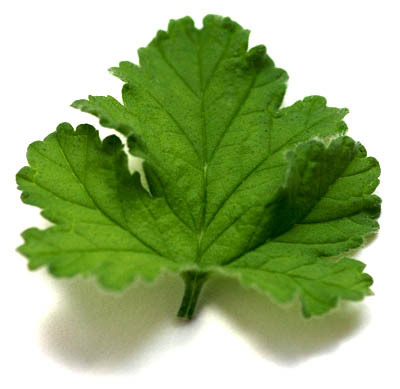Angelica, known in some parts as Holy Ghost or Wild Celery, is a member of the genus Umbelliferae, which also endows the kitchen with parsley, carrot, parsnip, fennel, anise, coriander, celery, dill, cumin, lovage and caraway. Its subtly sweet flavor hints at many if not all these sister plants, with prominent notes of licorice and celery. Its botanical name, angelica archangelica, derives from the legend that it was the archangel Michael who told of its medicinal use, and every part of the plant has been prized for centuries for remedies addressing diverse complaints, especially digestive and bronchial problems. The leaves are used for tea; the roots and seeds flavor wine and spirits, including gin, Chartreuse, Bénédictine, vermouth and absinthe; the ground dried root and candied stems are added to baked goods; and the fresh leaves enliven salads, soups, stews, custards and ice cream. A flute-like instrument with a reedy sound can even be made of its hollow stem (entertaining for kids), and I’ve also seen the stems used as straws for drinks.
Read More...
Twitter @glutton4life
12.16.10 Sunny Side Up
I'm a sucker for citrus. It's such a relief when oranges, grapefruit and lemons begin flooding in from California and Florida at this time of year. Although I adore very tart lemons, I also love the lightly sweeter and more perfumey Meyer variety. Their smooth, thin skin is an electric golden yellow that seems to compensate, just a bit, for the lack of sunshine these days. I grabbed an armload at Fairway yesterday and, since they are a bit fragile and don't keep for so long, I'm going to immediately turn them into syrup and marmalade. The former will make wonderfully refreshing spritzers, especially with the addition of fresh rosemary. The latter will nicely cut through the rich fattiness of roasts or perhaps even our Christmas goose. And, of course, you can always preserve some lemons, as I've done again this year. Here's a recipe from last spring, along with one for chicken tagine, and a place to order organic Meyer lemons, if you're so inclined.
Read More...
Read More...
10.20.10 Shiso Creative
I'm crazy about shiso and was thrilled that we were able to grow several plants in our garden this summer. Turns out they like a spot that is a bit shadier, neither wet nor dry. We had to rescue armloads of the stuff before the first frost as it immediately and tragically goes black and limp. But then there I was with tons of shiso and only a few ideas as to how to use it. I've always enjoyed the crystallized shiso leaves, coated in a brittle crust of sugar, that are part of the dessert plate at Matsuri, but I couldn't really see making them at home. And I do like the pickled umeboshi-plum-and-shiso roll that is on every classic sushi menu, but that would use up just a few leaves at most. I did go ahead and make a simple syrup infused with the smaller quantity of red shiso I had—great for cocktails and to mix with soda water—but that still left me with vast quantities of the green. A quick scan of the web revealed virtually no inspiration, aside from an edamame salad enlivened with chopped shiso. So I put on my special Glutton's Thinking Cap (looks something like this, or perhaps this), gazed deep into the vast recesses of the fridge, and came up with a rather inventive way to use large handfuls of deliciously pungent, minty shiso.
Read More...
9.10.10 Black Ice
For much of the year, we follow a regular Saturday schedule: the dump; the farmers market in Barryville; Riverbrook Farm, Silver Heights Nursery and the dairy farm in Cochecton. It's an intense session of locavore foraging and so deeply satisfying. Whatever produce we're not getting from our own garden we get from Riverbrook Farm (along with fresh eggs and some goat and lamb meat), but they don't grow fruit, so we've been lucky to have a steady stream from some lovely people at the Barryville farmers market. We've had red currants, gooseberries, strawberries, apricots, blackberries, at least 8 varieties of raspberries, all kinds of plums (golden, red, sugar, black, Italian), delectable peaches (white and yellow) and now crisp, flavorful apples have begun to make an appearance. My pantry shelves hold jars of plum preserves. Tucked away in my freezer, along with the tomato sauce, are liter freezer bags filled with blackberries, raspberries and peaches. The trick to freezing berries is to spread them first on parchment-lined cookie sheets. Then, once frozen, slide the little nuggets into ziploc freezer bags or other airtight containers. This way, all year long you can have sorbet, ice cream, smoothies and even pie that taste of sweet summer. Speaking of sorbet, I made one with blackberries that was so divine, I can't resist making it again right away.
Read More...
Read More...
7.24.10 Peachy Keen
A bowl of white peaches sat on the counter, their rosy, fuzzy curves as innocent and perfect as those of a child. Their sweet fragrance would waft towards me whenever I walked past and, after a few days, they hovered at that turning point of ripeness that demands attention. My freezer already held a bag of white peach purée, ready to recreate the bellini of my dreams, exemplified by that one on a freezing January day at the crowded, overheated bar at Harry's in Venice, surely among the most glamorous and decadent meals of my life. (When you go there, stick to bellinis and panini at the bar.) There were six peaches—too many to simply eat out of hand now that they were on the verge of going soft. How then to take advantage of these delicate creatures?
Read More...
Read More...
7.19.10 The Ask: Chef Alex Raij
Alex Raij is the chef and co-owner of Txikito, a wonderful restaurant in Manhattan with its own uniquely personal take on Basque cuisine. I have eaten there on many occasions—on my own or with a friend for lunch, with groups big and small for dinner—and she has never failed to impress me with her imaginative and delicious cooking. El Quinto Pino, a more traditional tapas bar, is also part of her empire, which I'm sure will continue to diversify and grow in popularity. Chef Alex was kind enough to agree to an interview and submitted to a quick photo session with G. She even passed along a recipe for the basil pomada served at El Quinto Pino (I've done my best to adapt it faithfully). The result is the first of what I hope will be a series of interviews on gluttonforlife.
Read More...
Read More...
7.7.10 All You Need Is Lovage
Meet lovage (Levisticum officinale), known to the French as céleri bâtarde, or fake celery. It really is like celery but without the stalk; its lush leaves have a very similar green, herby, slightly salty flavor. Since it's considered a "magic bullet" companion plant—one that improves the health of all surrounding plants—it always has pride of place in our vegetable garden. It's second only to capers in its concentration of quercetin, a plant-derived flavonoid that has anti-infammatory and antioxidant properties. The Greeks and Romans chewed lovage seeds to aid digestion and, perhaps because of its name, lovage has been used in tonics and potions to conjure up true love. An infusion of the seeds is said to to erase freckles, although it may also cause photosensitivity. The plant grows easily and quickly; pinch it back to make it bushier and to deter the flower spikes. Once they start showing, the flavor becomes quite strong. Use the leaves to make a compound butter, in soups and stocks or, our favorite way, in a simple syrup. This is ideal for cocktails or simply mixed in with sparkling water for a refreshing summer drink.
Read More...
Read More...
1.31.10 Laid Out In Lavender
I brought this lavender and rosemary back from LA with me, stuffed into a plastic bag in my suitcase. It seems like they are growing everywhere there. Such a treat when the only living thing in our garden here is the hardy winter rye we planted to help restore our vegetable beds. For the past few days, I've been able to reach out and pinch these lovely sprigs, releasing their sharp-sweet fragrance onto my fingertips. (The smell of lavender has been proven to reduce stress.) Don't you just love having flowers in the house? Their beauty goes through so many phases, even when at last they droop and give up their petals. I especially like it when they come from the fields or my own garden. I'm dreaming even now of those two weeks in June when I'll have all the peonies I can handle. Check out these beauties from last year...
Read More...
Read More...
11.7.09 Grindhouse
You can really connect with your inner cave woman when using a mortar and pestle. Or maybe it will take you back to Baba Yaga, that terrifying witch of childhood fables who flew around in a mortar, using her pestle as a rudder. There's something very primal about them, although you can see that the one I have, above, is pretty civilized. I also have a deeper one made of something very hard (cement?) that I use for making papaya salad Thai-style, and a small wooden one I use for crushing herbs. Real pesto aficionados always rely on a mortar and pestle.
Read More...
Read More...
9.10.09 Scented Geraniums
I love scented geraniums (pelargonium). Their sweetly spicy aroma makes me swoon and revives me all at once. (I wonder if this is why they were so popular with Victorian ladies?) There are so many different varieties—apple, lime, ginger, lemon, rose, frankincense—and they retain their smell all year long. The oil exuded by their leaves is said to repel mosquitoes and biting flies; it is also antibacterial and speeds the healing of cuts and burns. My friend Kenny wears it as his signature fragrance. A couple of drops on your pulse points and you smell great all day long. You can also use scented geraniums in cooking: to flavor sugar or simple syrups; to line the bottom of a cake pan before pouring in the batter; in vinegars and marinades; combined with lemon balm or mint for tea.
Read More...
Read More...






